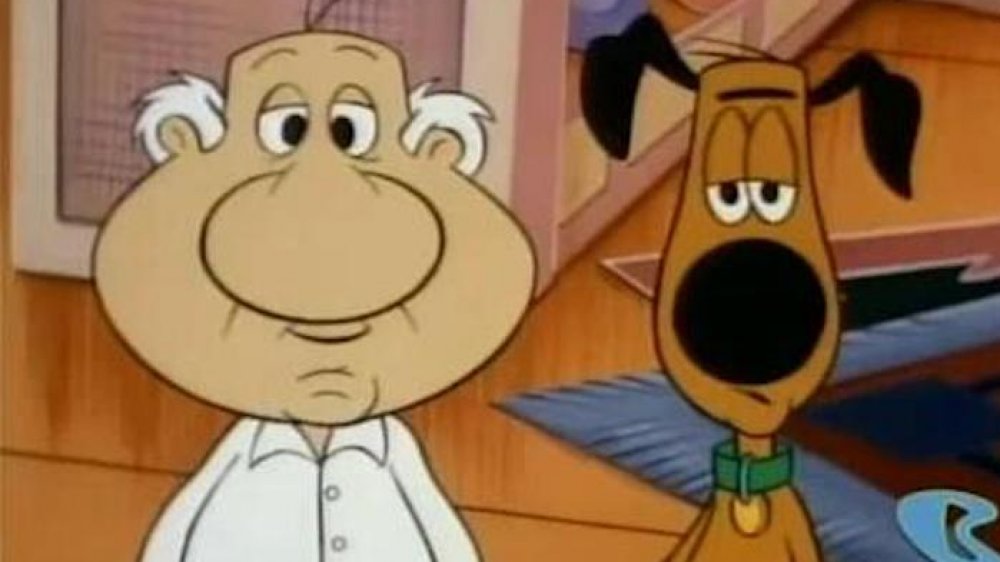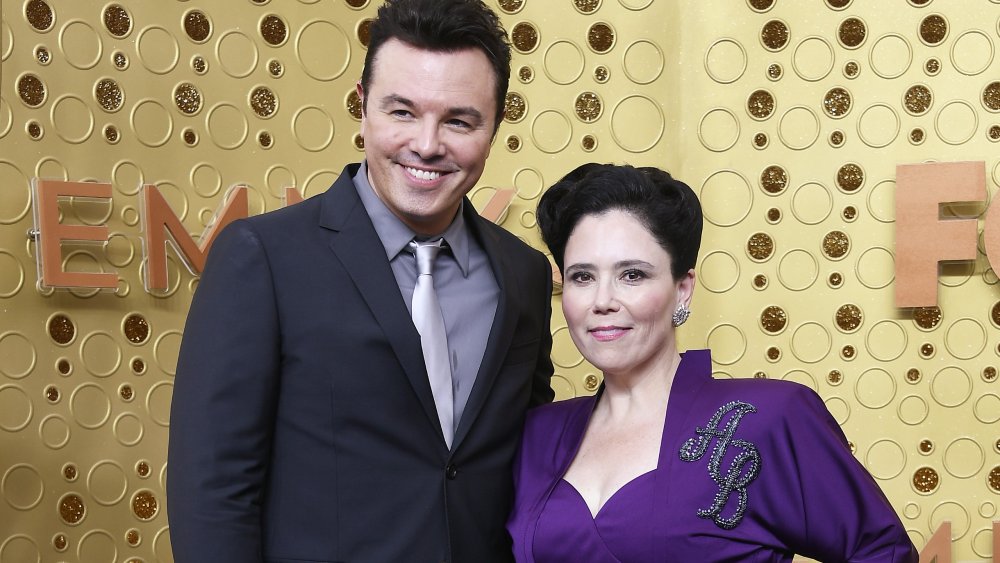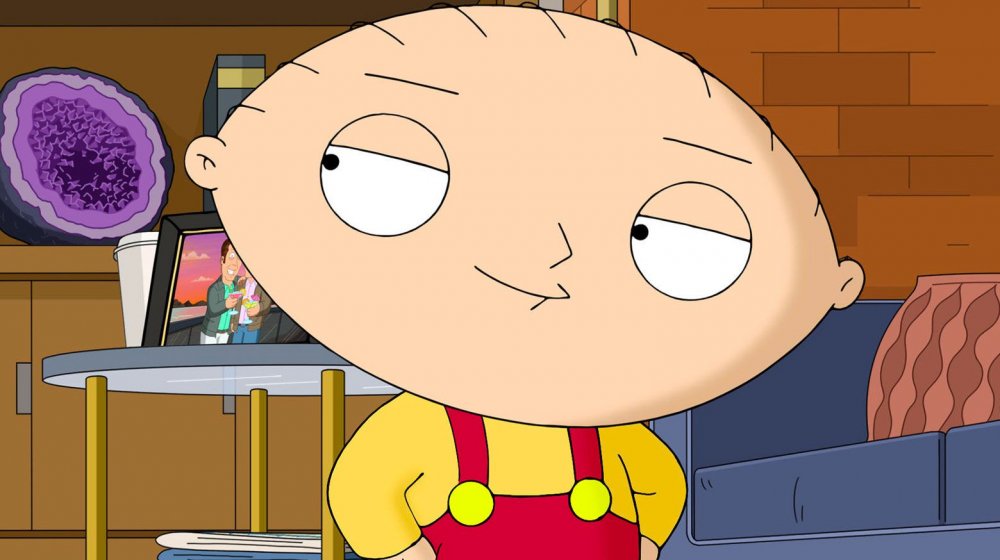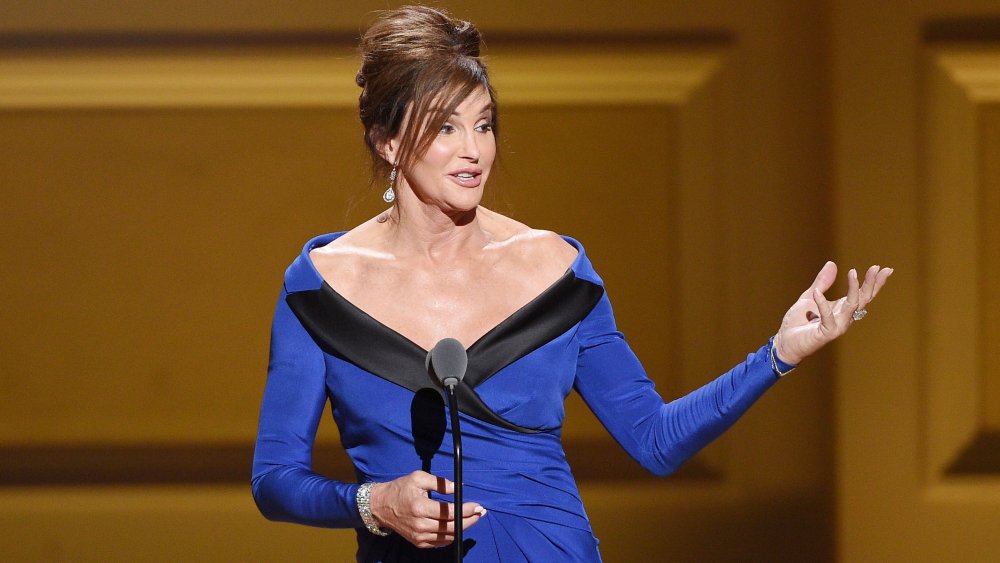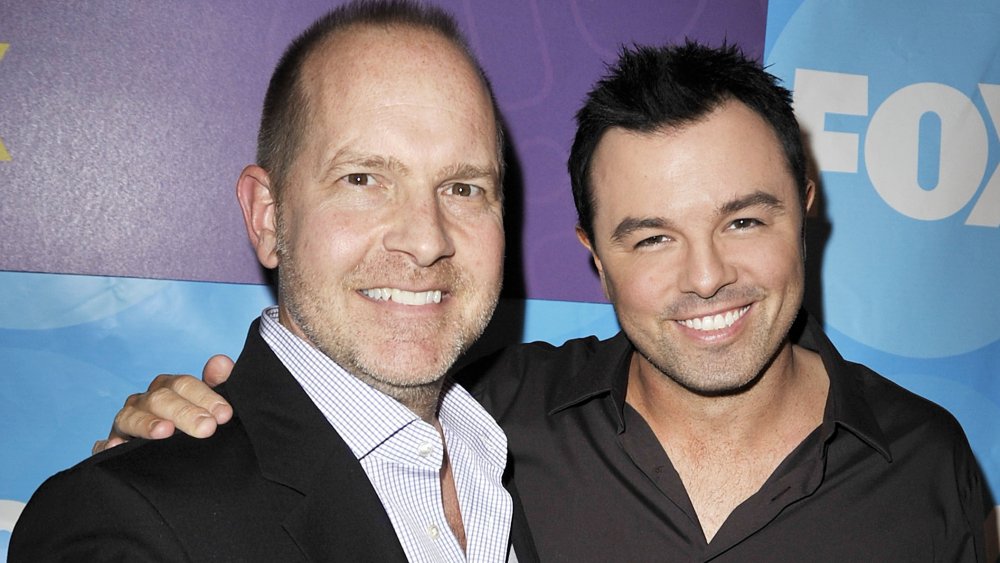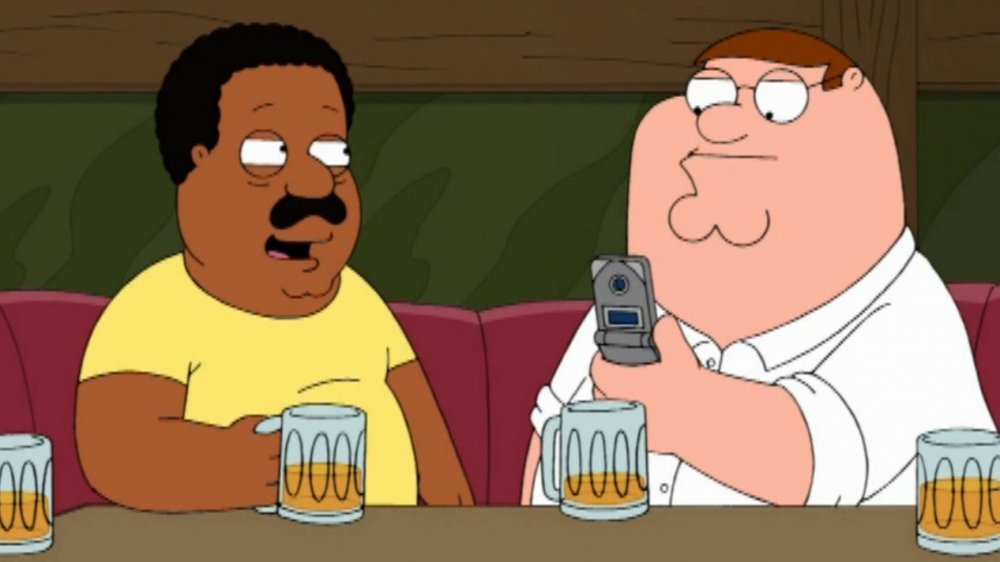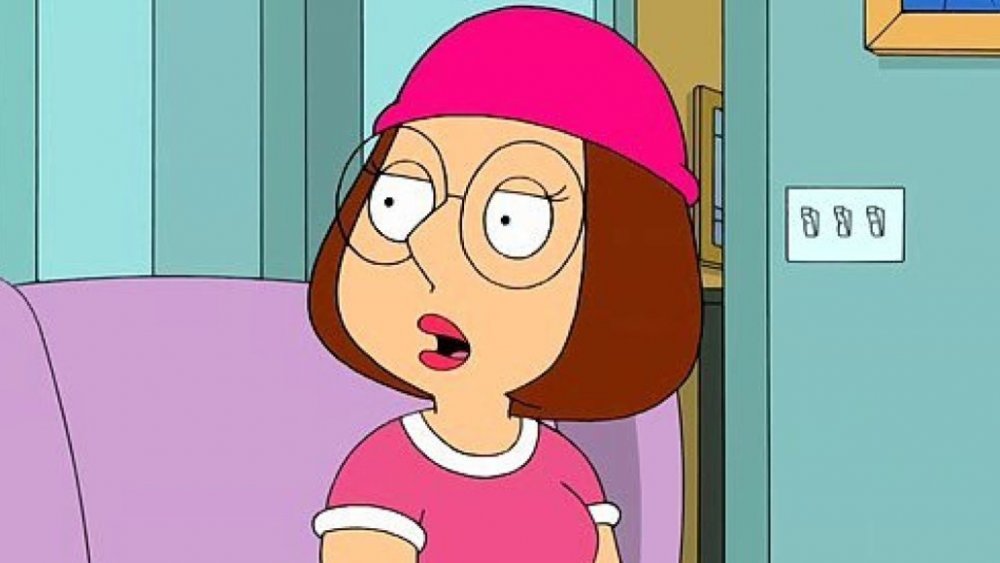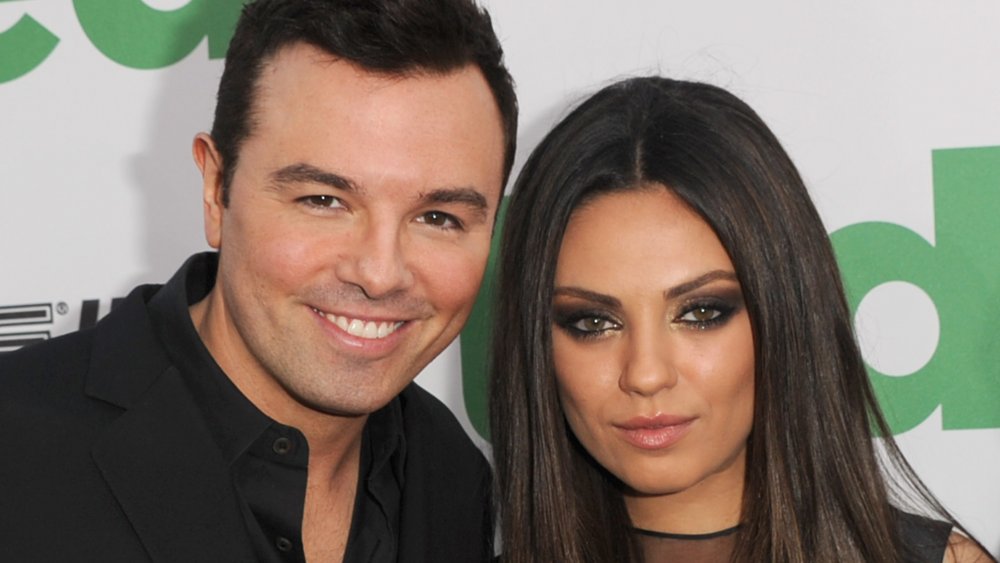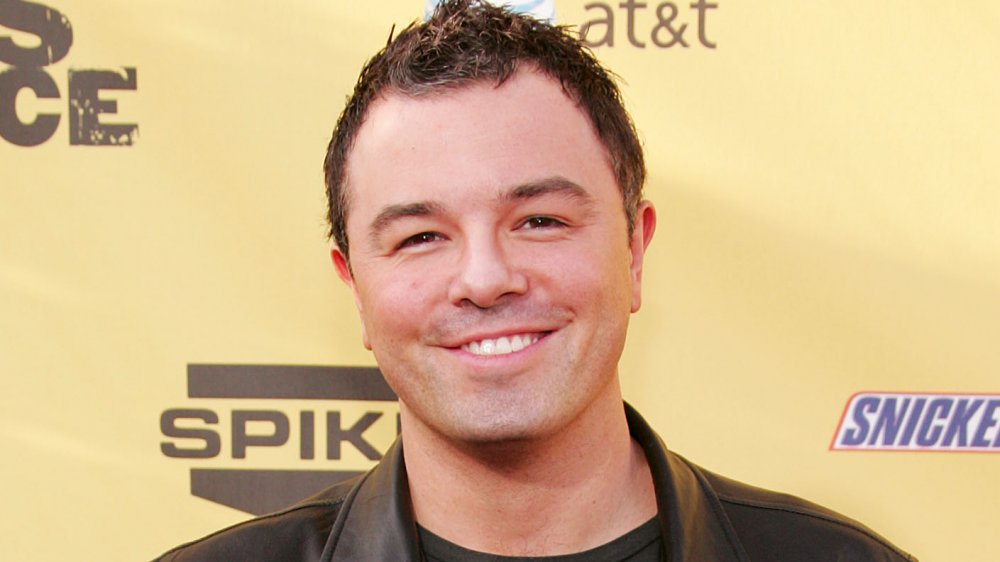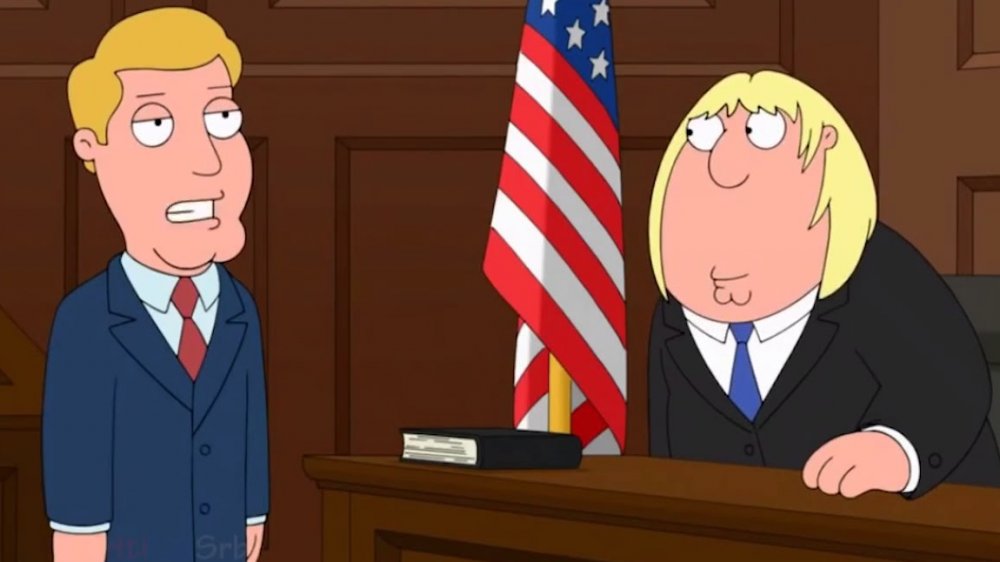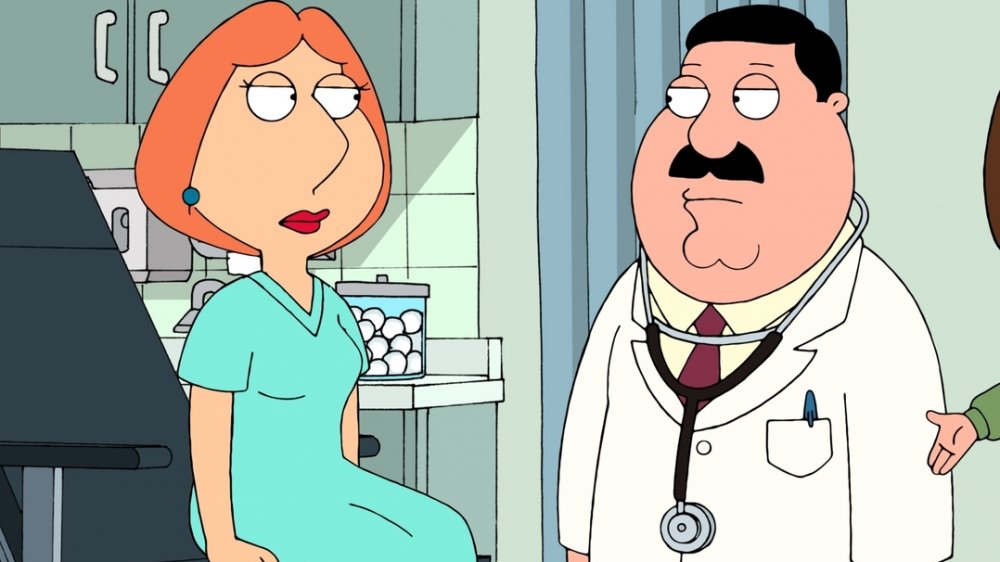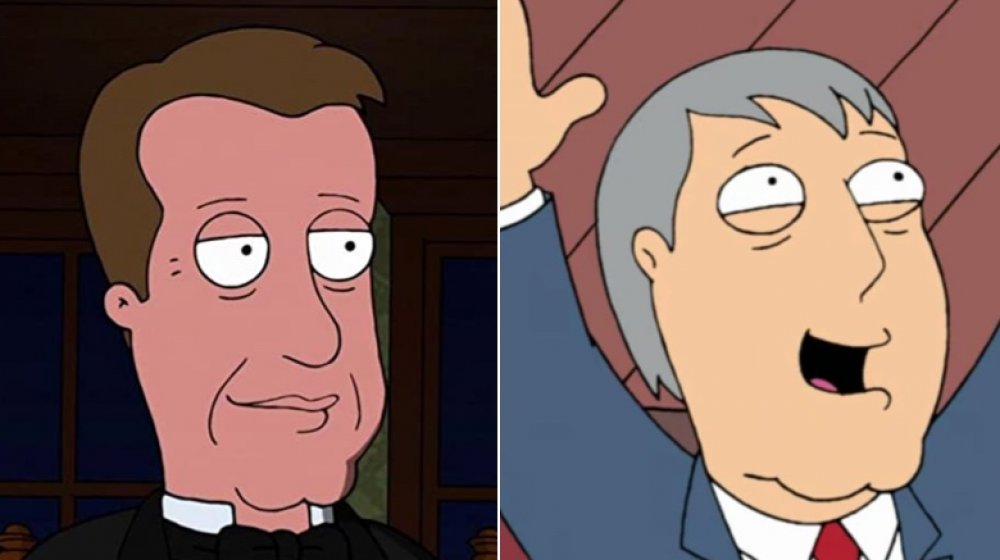The Untold Truth Of Family Guy
A cult hit upon its launch in the late '90s, Family Guy re-emerged years later as a cultural juggernaut and one of Fox's biggest and most enduring series. And despite the word "family" in its title, Family Guy is decidedly not a show for the whole family, as it's a consistent and hilarious source of crude, edgy, and raucous humor. But it's not all mass vomiting. Family Guy also skewers American life and celebrity culture, it perfected the absurdist "cutaway" gag, and it frequently stages elaborate musical numbers and episode-length tributes to Star Wars and old Bing Crosby/Bob Hope movies.
On top of all that, Family Guy has also given the world some of the most unique characters in TV history, from the monstrously selfish and stupid Peter Griffin to pompous talking dog Brian to Stewie, a baby with a British accent who was once bent on world domination and killing his mother. The series is a big world with lots of behind-the-scenes tales, so turn off Road House, postpone that fight with a giant chicken, and let's discover the untold truth of Family Guy.
Before Family Guy, there was Life with Larry
In 1995, for his senior thesis at the Rhode Island School of Design, Seth MacFarlane made a cartoon called "The Life of Larry," about a middle-aged, overconfident fool named Larry and his hyper-intelligent dog, Steve. And after the short made its way to Hanna-Barbera, MacFarlane found himself hired. He worked in the art department of What a Cartoon!, a Cartoon Network anthology that launched the series Johnny Bravo, where MacFarlane also toiled as a writer. On top of all that, the young animator subsequently put together another short starring Larry and Steve (appropriately titled "Larry & Steve") which he managed to get onto What a Cartoon!
But after working on kids shows, MacFarlane wanted to pursue more mature projects. After all, his Larry and Steve pieces leaned that way, but Hanna-Barbera and Cartoon Network weren't interested. "At the time, it was primarily a kids audience," MacFarlane told IGN. So MacFarlane pitched his idea to Fox, with Larry now named Peter, Steve now Brian, and with a fleshed-out world. The network turned him down, but a year later, MacFarlane re-approached the company, which gave him $50,000 to film a pilot. After six months of "animating like crazy at home," he had a "crudely animated film — with just enough to get the tone of the show across." Fox loved the cartoon, and he found out that Family Guy had been picked up for 13 episodes via an early morning phone call from his mother, who'd read the news in a show business trade magazine.
The Family Guy / MADtv connection
The Simpsons — the longest-running prime-time cartoon of all time — started life as a recurring segment on The Tracey Ullman Show, Fox's late '80s sketch comedy series. Family Guy, the second longest-running prime-time cartoon of all time, also almost started off as a feature on a Fox sketch series. "Family Guy was supposed to be a series of shorts on MADtv," creator Seth MacFarlane told IGN. It ultimately never came to pass because the sketch series, still early in its 15-season run, "didn't really have the budget to do any kind of animation at that point."
Nevertheless, MacFarlane found a very important piece of the Family Guy puzzle at MADtv. While circling the show, he recruited cast members to voice characters in the cartoon segments, including Alex Borstein, whom MacFarlane thought could play the mother figure. "I was asked to help out," Borstein told Metromix. "At the same time, I was doing a live stage show in L.A., playing a redhead mother in a sketch. I stole that voice from a cousin of mine in Great Neck." That character — with that voice — became Lois Griffin.
Family Guy was canceled twice
In February 2020, Family Guy aired episode number 344. That makes it only the fourth scripted, prime-time comedy series to produce that many episodes, joining The Simpsons, The Adventures of Ozzie and Harriet, and My Three Sons. All of those shows were stable hits ... except for Family Guy. After a middlingly successful first season (it ranked #55 in the 1998-99 Nielsen ratings), Family Guy dropped to 114th place for season two. At that point, and perhaps rightfully, Fox canceled the show, only to change course a couple of months later and order up a third season. After those episodes aired (across an ever-changing time slot and little promotion), Fox canceled the show yet again in 2002.
With around 50 episodes produced at that point, it was enough to send into rerun syndication. According to The Motley Fool, Fox worked out a deal with Cartoon Network, which was in need of content for Adult Swim, its fledgling late-night block of edgier fare. Per the agreement, Cartoon Network paid almost nothing to air Family Guy, so long as Fox could advertise Family Guy DVD sets. The arrangement was mutually successful. Family Guy brought in great ratings for Adult Swim, and the first DVD collection sold 2.8 million copies. Those figures, along with the relentless prodding of Fox executives by Family Guy creator Seth MacFarlane, led to a revival of the series in 2005, where it's remained a fixture of Fox's Sunday night schedule ever since.
Family Guy eerily predicted several news events
If there's one thing Family Guy does differently than other animated series (not counting the bizarre "cutaway" gags to impossible events), it's to make fun of celebrities. The show's writers can be absolutely savage, but a few times, the jokes have proven oddly and accurately prophetic.
For example, in a 2009 episode, baby Stewie makes a crude comment about celebrity offspring Brody Jenner emerging from his mother — '70s athlete turned reality TV star Bruce Jenner. Confused, Brian reminds Stewie that Bruce Jenner is a man, to which Stewie replies, "Bruce Jenner is a woman. An elegant, beautiful Dutch woman." In a watershed moment for the transgender community in 2015, Bruce Jenner announced that he was transitioning to female and would live life truthfully from that point as a woman named Caitlyn Jenner. A few months later, during a conference call with reporters, show creator Seth MacFarlane was asked about the origin of the predictive joke but said he was "too savvy to comment on the issue to the media."
Then, in a cutaway from a 2005 episode, a nude, panicked Stewie runs through a mall, shouting, "Help! I've escaped from Kevin Spacey's basement! Help me!" Nothing much was thought of the bit until 2017, when actor Anthony Rapp alleged that in 1986, Spacey invited him to his apartment for a party and then made aggressive advances on him. At the time, Rapp was 14 — like Stewie, a child.
Mike Henry went from obscurity to Family Guy fame
When Family Guy hit the air in 1999, 24-year-old Seth MacFarlane became the youngest executive producer in television. He wisely stacked the show's writing staff with veterans like David Zuckerman (The Fresh Prince of Bel-Air) and Chris Sheridan (Living Single). He also hired Mike Henry, whose job penning Family Guy scripts was his first major show business gig. So how did Henry land it? Friendship and luck.
After graduating from college in 1988 with a degree in history, Henry worked at a Virginia advertising firm for a short while before quitting to pursue comedy and acting, moving to Los Angeles to study with the Groundlings troupe and take both screenwriting classes at UCLA and cinema classes at the American Film Institute. At one point, he jetted out to the Rhode Island School of Design, to act in student films made by his brother, Patrick. While there, he met a budding animator — MacFarlane. "We immediately hit it off and cracked each other up and kept in touch," Henry told Backstage.
Then Henry spent a year in New York as an out-of-work commercial actor, which ended when MacFarlane called him to offer him a job writing for his new Fox series, Family Guy. By the show's third episode, he was voicing characters. Then in 2005, he became a producer, and in 2009, he headed up The Cleveland Show, the Family Guy spinoff featuring his character, deli operator Cleveland Brown.
Where the voice actors found their inspiration
Voice actors pull from everywhere to find the right tone for their characters. For example, Family Guy creator Seth MacFarlane plays Peter Griffin, and the voice is an impression of a security guard who worked at his college, the Rhode Island School of Design. According to MacFarlane at a Paley Center for Media event, the guard had a "thick Rhode Island accent" and "absolutely no self-editing whatsoever." MacFarlane also voices baby Stewie Griffin, whose English accent was born out of an impression of My Fair Lady star Rex Harrison that MacFarlane did in college "in order to get girls."
Mike Henry voices a few important supporting characters, notably Cleveland Brown. "I based Cleveland off a guy I met playing basketball who pronounced Maryland like 'Merlin.' He had a funny voice, and I started mimicking him," Henry told Campus Times. His other character, local predator Herbert, is "based on an old man I used to see at a grocery store."
Around the time he was working on the movie Can't Hardly Wait, Seth Green auditioned to play Chris Griffin. He ran some voice ideas past his friend and co-star Charlie Korsmo. "We were playing around with the voice," Korsmo told Page Six. "The one voice we used to do was Buffalo Bill from Silence of the Lambs. Our idea for his voice was to do Buffalo Bill as an 11-year-old boy," and that's Chris, more or less.
The real reason why Meg's voice suddenly sounded different
Meg Griffin, despised and neglected by her family, survived an actor switch. For the first season and part of the second, Lacey Chabert, best known at the time for her work on Party of Five, voiced Meg. Then, all of a sudden, the distinctive voice of That '70s Show star Mila Kunis came out of the overlooked, pink hat-wearing teen.
What happened? Well, Chabert was fired, if a biting joke from a 2009 episode is to be believed. When Peter takes over his father-in-law's company, he fires everyone, and Lois protests. "Keep it up, Lois, I might fire you, too," Peter threatens. Lois calls his bluff, to which he responds, "Does the name Lacey Chabert mean anything to you?" And Lois sheepishly backs off.
But according to Chabert herself, her departure was extremely noncontroversial. "I actually left the show of my own accord," she told GameSpy (via Sonic Retro). "And only because I was in school and doing Party of Five at the same time." However, creator Seth MacFarlane told IGN that it was "purely a contractual thing," adding, "I think there was a mistake in her contract, and I guess she had not intended to be involved for, like, the full run of the show." Chabert apparently harbored no ill feelings, because she returned to voice a rival Meg in a 2012 Family Guy episode.
Mila Kunis had a tough time becoming second Meg
After Lacey Chabert left Family Guy, the show needed to recast the role mid-production. Mila Kunis, already part of the Fox family with her role as Jackie on That '70s Show, got called in to read for the part. But the process wasn't easy for the actress. "There was an audition. I went on it," Kunis said at a Paley Center for Media event. "And then they said, 'You have to come back, but you have to speak slower.' And then they came back, and I thought I was speaking slower, and then I wasn't. And then they said I have to come back again and enunciate."
By that point, Kunis was so frustrated and mystified by what Seth MacFarlane and other members of the creative crew were after that she confronted them. "I'm over it," she recalls saying. "I don't even know what you want me to do." At that point, MacFarlane gave in and cast her as Meg.
Another contested Family Guy role was that of Brian the talking dog. MacFarlane wound up with the voice role, but William H. Macy auditioned for it. By that point, the Shameless star had already been nominated for an Academy Award for Fargo, but he couldn't land a job on a Fox cartoon. "I think I made a bad call," MacFarlane admitted on Twitter in 2010.
Seth MacFarlane doesn't write many episodes, and he never did
Seth MacFarlane is certainly one of the hardest working people in show business. At one point, he produced and voiced characters on three shows he at least co-created: Family Guy, American Dad!, and The Cleveland Show. While the latter was canceled, MacFarlane is now busy writing, directing, and starring on the live-action sci-fi series The Orville, and don't forget his side gig as a crooner in the vein of Frank Sinatra.
But while he voices three main characters on Family Guy and serves as a hands-on producer, he's no longer the chief creative voice behind the show — nor was he ever. While he created the series, he's only written for a mere three of the 350-plus episodes. MacFarlane wrote the 1999 pilot, a segment of a three-part 2002 anthology episode, and the first installment when the show was rebooted in 2005. He's fairly ambivalent about the starting point of his entertainment empire. "Part of me thinks that Family Guy should have already ended. I think seven seasons is about the right lifespan for a TV series," MacFarlane once told The Hollywood Reporter about a show now in its eighteenth season.
The show has been sued a few times
While Family Guy isn't afraid to get a little controversial, the times that the show's producers have found themselves embroiled in legal trouble, it's been for odd copyright concerns. In 2006, TV legend Carol Burnett filed a lawsuit over a Family Guy episode that depicted her custodian character from The Carol Burnett Show. In a scene in an adult bookstore, Quagmire notes that the place is "pretty clean. Carol Burnett works as a janitor." Viewers then see "Burnett" mopping a floor near a rack of dirty movies. Burnett alleged that the brief appearance of her character constituted copyright infringement. U.S. District Court Judge Dean Pregerson disagreed and dismissed the suit.
In 2009, Fox and Family Guy producers settled another infringement case. Bourne Co., the music publisher that controls the rights to the pop standard "When You Wish Upon a Star," sued over the Family Guy original song "I Need a Jew," featured in the episode "When You Wish Upon a Weinstein." Bourne's attorneys alleged that the parody only barely changed the melody from the original song and had damaged the reputation of the old chestnut by adding "anti-Semitic lyrics." U.S. District Court Judge Deborah Batts ruled in favor of Family Guy, stating that the song was a work of parody (thus protected under the law) and that the new work was "strikingly" and sufficiently different from "When You Wish Upon a Star."
There's a banned episode of Family Guy
Family Guy writers push the envelope, and as a result, the series can be much more crude and callous than the average network TV show. (For example, it features a regular character, an old man named Herbert, who aggressively tries to seduce children — and it's played for laughs.) And while the show has to pass evaluation from Fox's standards and practices department, on one occasion, it went entirely too far. In 2010, Family Guy producers delivered the episode "Partial Terms of Endearment," which concerns Lois Griffin deciding whether or not to medically terminate an unwanted pregnancy. Fox refused to air the episode altogether but allowed for its inclusion on a future Family Guy DVD set.
Censors in Venezuela were much harder on the show. In a 2009 episode, Stewie and Brian sing a song about the joys of marijuana called "A Bag of Weed." While cutting out the offending clip could've been an effective move, Venezuela's minister of Interior and Justice instead banned the cartoon — all of it — from the country's airwaves.
Why Family Guy changed the name of James Woods High School
Family Guy is set in Quahog, Rhode Island, and for most of the show's run, the town mayor was actor Adam West, best known for his role on the '60s Batman TV show. West voiced a bizarre, disturbed variation of himself, but the actor sadly died in 2017, leaving Family Guy writers wondering how to honor the long-time cast member. At a show panel at San Diego Comic-Con (via Indiewire), executive producer Steve Callaghan said the show would change the name of Chris and Meg Griffin's high school to "Adam West Regional High School. "We thought it was fitting to pay tribute to him, not only as a character but a person in our lives," Callaghan said.
But the school already had a name. It had always been called James Woods Regional High School, after intense movie star James Woods, who grew up and resided in Family Guy's home state of Rhode Island. Some fans wondered if dropping Woods' name from the school was political, in that Woods is an outspoken Republican and show creator Seth MacFarlane is a staunch progressive. Woods tweeted that he considers MacFarlane "a dear friend," but at that same Comic-Con panel, Alex Borstein (voice of Lois Griffin) quipped that the move not only paid respects to West but was also a way to "stick it to James Woods!"

